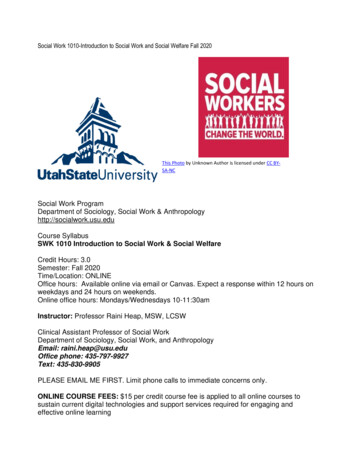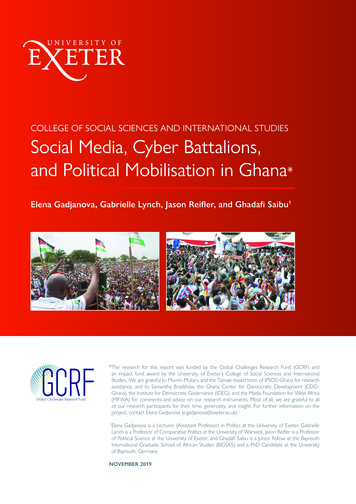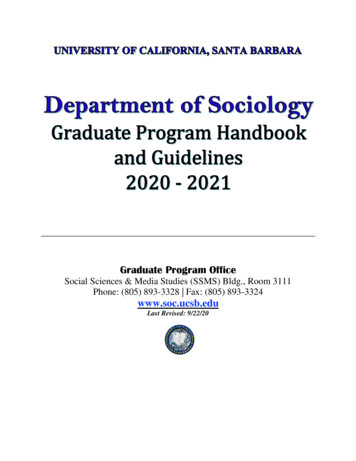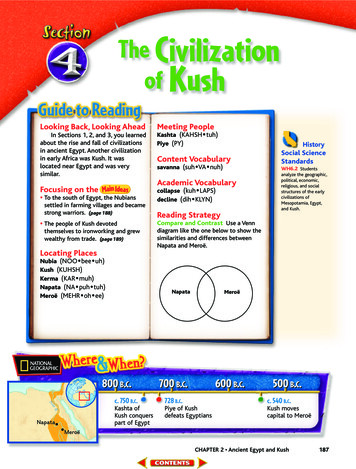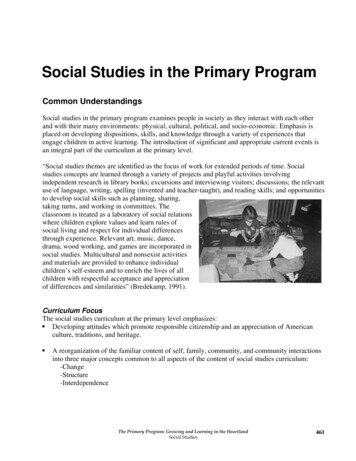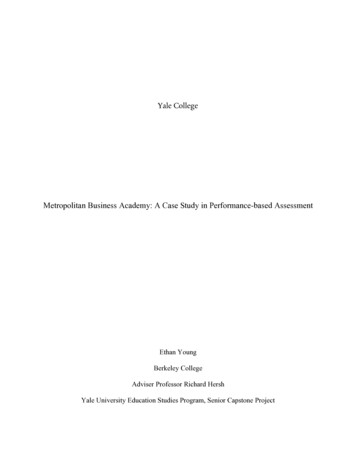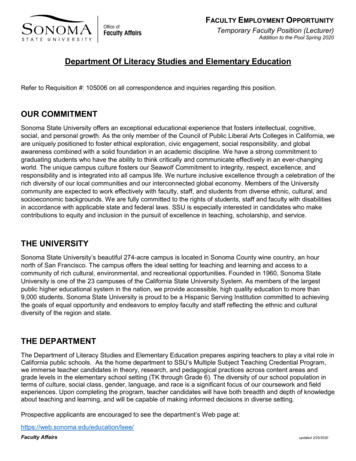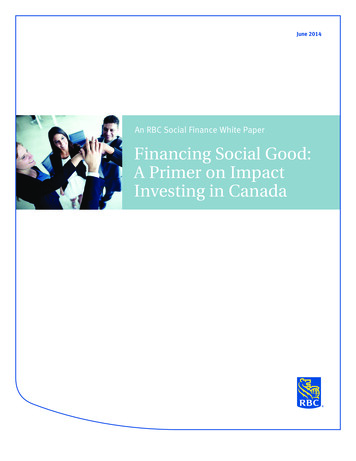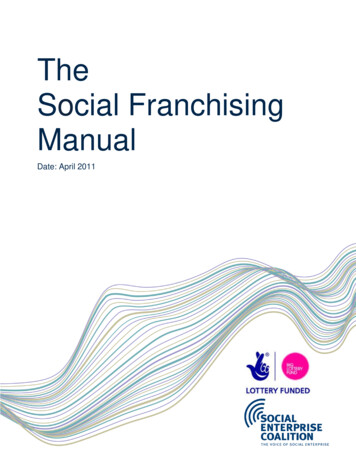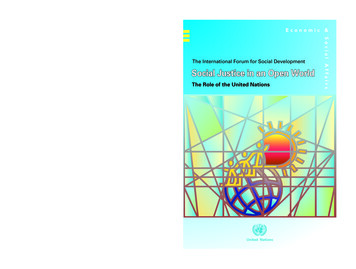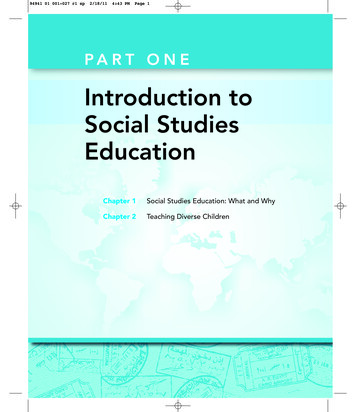
Transcription
94941 01 001-027 r1 sp2/18/114:43 PMPage 1PA R T O N EIntroduction toSocial StudiesEducationChapter 1Social Studies Education: What and WhyChapter 2Teaching Diverse Children
94941 01 001-027 r1 sp2/18/114:43 PMPage 2Chapter 1Social Studies Education:What and WhyChapter Outline1. Goals for Social Studies:3. Curriculum Standards:Social Understandingand Civic EfficacyNational, State, andLocal2. Curriculum Scope and5. Conclusion4. Five Key TrendsSequenceKey ConceptsGSocial studiesGScope and sequenceGAchievement gapGSocial understandingGCurriculum standardsG21st century skillsGCivic efficacyGGrade and unit topicsGTrendsGCurriculum goalsGConceptual themesP I C T U R ET H I SAs they enter the classroom, the kindergarten children are excited to find a large strip ofpaper going down the middle of the floor. Their teacher, Jacob Stern, tells them to hangup their coats and come sit beside the paper strip. The strip, hetells them, is a highway connecting two distant towns. Mr. Sterntakes a toy car and starts driving it along the highway. “Whatmight happen as someone drives along?” he asks. The childrensuggest a number of possibilities: running out of gas, gettingtired, and being hungry. “What services might be necessaryfor people as they drive from town to town?” Tanisha suggests a gas station. A milk carton is placed along the highwayand named “Tanisha’s Gas Station.”1
94941 01 001-027 r1 sp2/18/114:43 PMPage 3M A I N I D E A The purpose of social studies education is to helpstudents develop social understanding (i.e., knowledge of people andplaces near and far [geography] and now and then [history]) and civicefficacy (i.e., the ability to think and act as a democratic citizen in adiverse nation and an interdependent world).When I was in elementary school in Englewood, Colorado, just south of Denver,I loved social studies. I had brilliant teachers, and they taught us social studies every day, every week, and every month. It was serious social studies, not socialstudies “lite.” They introduced us to the knowledge and skills of the social scienceswhile preparing us to hold the highest office in the land: citizen. It was challenging,it was fun, and it was with social studies material that my reading and writing skillsdeveloped.Those of us from Lowell Elementary School appeared to our middle schoolteachers to be the smart kids, which was not the case; we were just well taught. Priorknowledge always makes a student look smart. Our elementary teachers gave us thatgift: By the time we got to middle school, we already knew something about whatthese new teachers wanted to teach us. We had a foundation they could build on. Bestof all, the teachers at Lowell didn’t simply load us up with facts and skills. Theytaught us ideas and ignited a lifelong interest in them.My experience in elementary school fueled more than my love of social studiessubject matter. It also fueled my interest in how children can develop a solid foundation in social studies before they go on to middle and high school. I think of thatoften, and it pervades this book. In the primary grades (kindergarten–3rd), whatshould children be learning about social studies? And then how can they best buildon that in the intermediate grades (4th–5th)? And then in the middle grades(6th–8th)? Simply put, social studies education is powerful, and not having access toit, for whatever reason, is disabling intellectually, socially, and morally.Without historical understanding, there can be no wisdom; without geographical understanding, no cultural or environmental intelligence. Without economicunderstanding, there can be no sane use of resources and no rational approach todecision making and, therefore, no future. And without civic understanding, therecan be no democratic citizens and, therefore, no democracy.This is why social studies education matters. When children are empowered byknowledgeable and skillful teachers with the information, ideas, skills, and attitudesand values that compose the social studies curriculum, their judgment is improved.Consequently, they can reason historically, help solve community problems, embracediversity, fight intolerance and bigotry, protect the environment, and, with deepunderstanding, empathize with the hopes, dreams, and struggles of people everywhere.3
94941 01 001-027 r1 sp42/18/114:43 PMPage 4Chapter 1 Social Studies Education: What and WhyGoals for Social Studies: SocialUnderstanding and Civic EfficacyThere are two primary goals of social studies education, and they are the guidinglights of most social studies curriculum standards. “Standards,” as we will see laterin this chapter and throughout the book, are statements that describe what studentsshould learn—the desired results of instruction, also called objectives. But curriculum standards—whether national, state, or local school district standards—are notto be confused with the broad goals or purposes of curriculum and instruction. Standards make no sense unless we know the goals they are aiming to achieve. To get atthe goals of social studies, let’s begin with a definition.According to the National Council for the Social Studies (NCSS), social studies. . . is the integrated study of the social sciences and humanities to promote civiccompetence. The primary purpose of social studies is to help young people developthe ability to make informed and reasoned decisions for the public good as citizensof a culturally diverse, democratic society in an interdependent world.2On one side of this definition is the subject matter that is studied. “Subject matter” is the what of teaching and learning—the curriculum. It includes the facts (alsoknown as information or data), ideas, skills, issues (short for “controversial issues”),and methods of inquiry drawn from the seven social sciences: history, geography,civics and government (political science), economics, sociology, psychology, and anthropology. The humanities—philosophy, ethics, literature, religion, music, and thevisual and performing arts—are involved as well.3 These fields of study or “disciplines” serve as resources: The social studies curriculum draws on them, blendingand integrating them with two additional ingredients—students’ cultural experiencesand society’s needs. But to what ends? What is the purpose?On the other side of the definition is the purpose, “civic competence” or democratic citizenship: “the ability to make informed and reasoned decisions for the public good as citizens of a culturally diverse, democratic society in an interdependentworld.” Civic competence is the readiness and willingness to assume citizenship responsibilities. These responsibilities include more than just voting. For in a democracy, it is also one’s responsibility to serve on juries, to be lawful, and to be just.(“Injustice anywhere is a threat to justice everywhere,” famously said by MartinLuther King, Jr.4) One is expected to be tolerant of political and cultural differences,one is expected to participate in creating and evaluating public policy, and it is one’sduty to be civic-minded—to think not only of oneself and one’s own rights and freedoms but also of the good of the whole community.In a nutshell, then, social studies education has two goals: social understanding(i.e., knowledge of human societies) and civic competence (i.e., democratic citizenship). When developing any social studies unit or reading any set of curriculum standards for social studies, keep an eye on these two the goals.
94941 01 001-027 r1 sp2/18/114:43 PMPage 5Goals for Social Studies: Social Understanding and Civic EfficacySchools typically approach these two broad goals by way of three subgoals:knowledge, attitudes and values, and skills. More specific objectives (or “standards”)are typically listed under each subgoal. When readers examine their state and localsocial studies curriculum standards, they will most likely find that the standards takethis form or one that is similar. Please take some time now to find out.KnowledgeWhich social knowledge is most important? We can answer this question in threeways: disciplines, themes, and topics.One way to determining which social knowledge is most important is to refer tothe disciplines (also called fields) of study. These are the seven social science disciplines and the humanities. Within these disciplines, knowledge is systematically created, interpreted, critiqued, and revised continually in a never-ending process ofdisciplined (i.e., it’s systematic, not random or without rules of inquiry) knowledgeconstruction. But these are large fields containing huge amounts of ideas, information, and methods of inquiry.Another approach is to identify a set of basic content themes. Themes help curriculum planners and teachers narrow the scope somewhat and give them a betteridea of which social knowledge deserves the most attention. The Curriculum Standards for Social Studies created by the National Council for the Social Studies identifies 10 such themes. They have become the best-known knowledge themes for socialstudies instruction in the elementary and middle grades and have been incorporatedinto a number of state and local social studies standards frameworks:1. Culture2. Time, Continuity, and Change3. People, Places, and Environments4. Individual Development and Identity5. Individuals, Groups, and Institutions6. Power, Authority, and Governance7. Production, Distribution, and Consumption8. Science, Technology, and Society9. Global Connections10. Civic Ideals and PracticesPlease take a minute now to look at A Sampler of Curriculum Standards forSocial Studies. You can find it at this textbook’s website at www.myeducationlab.com. Find the brief descriptions of each of the 10 themes. The remainder of theSampler spells out each of these 10 standards and gives teaching examples called“snapshots.” This will be a helpful resource for you as you plan lessons and units.5
94941 01 001-027 r1 sp62/18/114:43 PMPage 6Chapter 1 Social Studies Education: What and WhyA third way to answer the “Which knowledge is most important?” question isto identify topics. There is no shortage of topics, and of course they cannot all betaught and no one would want to learn them all. One scholar, E. D. Hirsch, Jr., produced a list of over 5,000 topics that he thought elementary school children in theUnited States should learn in order to give them a common knowledge base.5 Without this, he argued, there can be no common culture that bridges our many culturaldifferences. But most educators, while sympathetic to Hirsch’s thesis that sharedknowledge is important, found his list too long and too fragmented to be of muchhelp in curriculum development. A more typical and manageable set of topics for unitdevelopment in each of the elementary grades appears in the next section on curriculum scope and sequence. For example, elementary students should know:GGreat river systems of the worldGDesert cultures and forest culturesGFood, clothing, transportation, and shelter (now and then, near and far)GAncient societies and modern societiesGGeographic regions of the United StatesGThe American Revolution and ConstitutionGRights and responsibilities of citizensAttitudes and ValuesThe second subgoal of social studies learning—attitudes and values—is directed lessat cognitive knowledge and more at emotion, feeling, and beliefs about right andwrong. Particular attitudes (also called dispositions, traits, and virtues) and valuesare essential to democratic citizenship. Sometimes these are divided into two categories and listed separately, as we will see in Chapter 3, but for now we can lumpthem together in order to distinguish them from knowledge and the third subgoal:skills. Without attitudes and values, like a boat without a rudder or a hiker with nocompass, democratic government and civic life would be impossible. The followingare typical of what is listed in state and local curriculum guidelines.1. Being committed to the public values of this society as suggested in its historical documents, laws, court decisions, and oaths (e.g., from the Declaration ofIndependence, “all men are created equal”; from the Pledge of Allegiance,“liberty and justice for all”)2. Being able to deal fairly and effectively with value conflicts that arise whenmaking decisions about the common good (public policy)3. Developing a reasoned loyalty to this nation and its form of government.(Note that the Pledge of Allegiance is made not to a person, but to a form ofgovernment: a “republic”; that is, a constitutional democracy)4. Developing a feeling of kinship to human beings everywhere—to the humanfamily
94941 01 001-027 r1 sp2/18/114:43 PMPage 7Goals for Social Studies: Social Understanding and Civic Efficacy75. Taking responsibility for one’s actions and fulfilling one’s obligations to thecommunitySkillsThe third subgoal—skills—identifies what students should know how to do. Ofcourse, doing involves knowing; skillful behavior is skillful to a great extent becauseof the knowledge that supports it. A child is skillful at something because he or sheknows how to do it well. A skill, then, is also called know-how or procedural knowledge. Skills are often subdivided as follows:I. Democratic Participation SkillsA. Listening to and expressing opinions and reasonsB. Participating in classroom, school, and community decision making,especially participating in group discussions of public issues(classroom, community, international) with persons with whom onemay disagree; leading such discussions; mediating, negotiating, andcompromisingC. Working cooperatively to clarify a task and plan group workD. Accessing, using, and creating community resourcesII. Study and Inquiry SkillsA. Using and making time lines, maps, globes, charts, and graphsB. Locating, reading, and analyzing information from a variety ofresources, such as books, encyclopedias, the Internet, newspapers, andlibrariesC. Writing reports and giving oral presentationsD. Distinguishing between primary and secondary sourcesE. Forming and testing hypothesesIII. Intellectual Skills (critical thinking and problem solving)A. Comparing and contrastingB. Making and evaluating conclusions based on evidenceC. Identifying and clarifying problems and issuesD. Distinguishing fact from opinionE. Inferring cause-effect relationshipsAs you will see later in this chapter, there is today aflurry of activity to identify what are being called “21stcentury skills.” These cut across the school subjects (math,science, social studies, language arts) and hope to present“a holistic view of 21st century teaching and learning.”6Critical thinking, collaboration, and media literacy areemphasized. This is an exciting trend that may helpschools innovate and transform teaching and learning forthe current era.REFLECTIONMany school subjects comprise knowledge and skills, but social studies emphasizes attitudes and values,too. How are they different, and why areboth important?
94941 01 001-027 r1 sp82/18/114:43 PMPage 8Chapter 1 Social Studies Education: What and WhyCurriculum Scope and SequenceSo far we have been considering the goals of social studies teaching and learning.Now it is time to understand the idea of “scope and sequence.”Building a firm foundation in an earlier grade to support learning that shouldoccur in a later grade is the reason curriculum directors and standards authors carefully plan the scope and sequence of a social studies program. The scope of the program refers to the subject matter—the knowledge, values and attitudes, andskills—that the program is to include. The sequence is the order in which the varioussubject matters are to be presented.As for scope, it is not the purpose of the elementary school to teach the socialscience disciplines apart from their relevance to children’s lives or society’s problemsand needs. Disciplinary knowledge should be taught in ways that will help childrengain insight into the social and physical world in which they live. When children aremaking islands and mountains on the classroom floor or learning to draw maps ofthe playground, they are dealing with geography in simple ways. When they are askedto explain why they need agreed-upon rules in the games they play and then dramatize the signing of the U.S. Constitution, and then create a classroom constitution—a rule book they agree to follow—they are having their first brush with history andgovernment. Moreover, the teacher is connecting the social studies curriculum to students’ lives outside school. When students compare and contrast the playground bullyto the elected classroom president, they are beginning to understand basic ideas frompolitical science (law and legitimate authority). In these ways, the subject matter isconnected to what the children already know and do. But the curriculum also broadens their horizons, taking them to distant places and times—to the signing of the Constitution in Philadelphia, the life of a scribe in Cleopatra’s court, the sisters and theircousins who carry drinking water from the well to their village in the Sahara desert,and village life in one of the first farming communities thousands of years ago. So,the social studies curriculum is connected to the child’s life, and it enlarges that lifeoutward to include the less familiar, the far away, and the long ago. Of course, roleplaying and simulations—playing, pretending, and imagining—help to make all thisvivid and concrete. Being asked what really happened and how they know that to betrue, again and again, familiarizes them with the “disciplined” ways of knowing thatmark the social sciences.As for curriculum sequence, ordinarily topics that have a concrete and familiarfocus for children are included in the primary grades—topics such as homes andhouses, schools and stores, local rivers and lakes, the clothes (what anthropologistscall “costume”) the children are wearing and the foods they are eating and wherethese come from and how they are grown and shipped. Topics that are more remotein space and time, such as the nation, the United Nations, and regions of the world,are focal points in the intermediate and middle grades. It must be emphasized, however, that this does not mean that first-graders spend a year studying their own families, or that second-graders study only the local neighborhood or third-graders only
94941 01 001-027 r1 sp2/18/114:43 PMPage 9Curriculum Scope and SequenceDramatizationswith simple sets bringgeography to life.(Photo courtesy of AnthonyMagnacca/Merrill)the local community. Rather, a compare-and-contrast approach should be used, forit builds intellectual strength and conceptual power, and broadens students’ horizons.For example, children should learn how local houses and apartments are similar toand different from shelters long ago and far away. The same is true for families, neighborhoods, and communities.Here is a popular scope-and-sequence plan from the National Council for theSocial Studies.Kindergarten—Awareness of Self in a Social SettingGrade 1—The Individual in Primary Social Groups: Understanding Schooland Family LifeGrade 2—Meeting Basic Needs in Nearby Social Groups: NeighborhoodsGrade 3—Sharing Earth-Space with Others: CommunitiesGrade 4—Human Life in Varied Environments: RegionsGrade 5—People of the Americas: The United States and Its NeighborsGrade 6—People and Cultures: The Eastern HemisphereGrade 7—A Changing World of Many Nations: A Global ViewGrade 8—Building a Strong and Free Nation: The United StatesGrade 9—Systems That Make a Democratic Society Work: Law, Justice, andEconomicsGrade 10—Origins of Major Cultures: A World HistoryGrade 11—The Maturing of America: United States HistoryGrade 12—One-year course or courses required, such as U.S. Government &Politics; Comparative Government & Politics; Problems of Modern Society;International Studies79
94941 01 001-027 r1 sp102/18/114:43 PMPage 10Chapter 1 Social Studies Education: What and WhyA powerful sequencing principle is the “spiral” curriculum. As the brilliant psychologist Jerome Bruner described it, “ideas are first presented in a form and language (that) can be grasped by the child, ideas that can be revisited later with greaterprecision and power until, finally, the student has achieved the reward of mastery.”8A concept like “family” can be grasped—in a very simple way—by the five-year-oldwith reference to her own family, families that live nearby, and the families of herfriends and relatives. She notices the similarities and differences across these nearbyexamples and constructs in her own mind the idea of “family.” But later, in a unit onfamily life in India and Kenya, she encounters new and different examples—includingthe Kenyan Masai family with many wives and children and not a cat or dog but acow. Then, in a high school Law and Society class, she learns about family law (custody issues, marriage benefits, civil unions, etc.). In college, she might write a thesiscalled “The Changing Family in Europe and Africa.” Through years of study of a single concept, the student’s understanding of it becomes increasingly complex—bothdifferentiated (she can talk about the similarities and differences that exist withinfamilies across history and geography) and elaborated (she has a detailed understanding of various examples and of the popular and scholarly debates that occur over thedefinition of “family”). Figure 1.1 displays one sketch of a plan for spiralling threeconcepts.Shall we pull all this together? Look again at the 10 themes identified in the Curriculum Standards for Social Studies. How might these themes be used with a scopeand-sequence plan of this kind? It is important to note that the 10 themes are ideasor, more precisely, concepts. Furthermore, as the Curriculum Standards for SocialStudies make clear, these themes are recommended as the basis for instruction in eachgrade, kindergarten through 12th. What we can do is select a grade level from theFigure 1.1 Spiral curriculum.Worldwide examplesgrade 6National examplesgrade 5State examplesgrade 4Local examplesgrade 3ClothingGovernmentCONCEPTLandform
94941 01 001-027 r1 sp2/18/114:43 PMPage 11Curriculum Scope and Sequencescope-and-sequence plan here (or one provided by your local school district) and usethe 10 themes to help plan conceptually rich units and lessons. Let’s select, as anexample, the grade 3 emphasis—communities—and think of some focus questionsthat will engage children with each of the 10 themes.What does this involve? The example that follows uses two resources to createa powerful third-grade social studies curriculum. I took the third-grade topic “Communities” from the preceding scope-and-sequence recommendation and then elaborated the scope of that topic by using the 10 conceptual themes from the CurriculumStandards for Social Studies.Take some time now to draft a similar example for another grade level. Thiswill provide experience in thinking conceptually about the social studies topical emphasis of a given grade level. We applied the 10 conceptual themes to the topic of communities, but the same process can be followed for the second-grade emphasis—neighborhoods—or the fourth-grade emphasis—geographic regions—or the fifth-gradeemphasis—United States history—and so on. You may need the accompanying Samplerto bolster your understanding of the 10 themes.GRADE 3SHARING EARTH-SPACE WITH OTHERS: COMMUNITIES1. Culture. How does life in our communitydiffer from life in our sister cities in Japanand Russia?2. Time, Continuity, and Change. Whatwere the turning points in our community’shistory?3. People, Places, and Environments. How didour community come to be located whereit is, and how would our lives be different ifit were located on the edge of the sea, in adesert, or high in the mountains?4. Individual Development and Identity. Howdoes learning in school differ from learningthat takes place elsewhere in our community—on the job, on the playing field, athome, at a city council meeting?5. Individuals, Groups, and Institutions. Whatafter-school clubs do young people belongto in our community, and how do they differ from those in our sister cities in Japanand Russia?6. Power, Authority, and Governance.What are the three branches ofgovernment in our community, and whoserves in them?7. Production, Distribution, and Consumption.What things do people in our communitywant and need? What do we make in ourcommunity and what do we have to import? How are these different from thewants and needs in our sister cities in othercountries?8. Science, Technology, and Society. How doour values influence the use of buses andcars in this community?9. Global Connections and Interdependence.What three products are imported in thegreatest quantities to our community? Areany products exported?10. Civic Ideals and Practices. Who is eligibleto vote in this community? Where canthey register to vote? What percentageof them voted in the last presidentialelection? In the last local election? Whatcan our class do to encourage eligiblevoters to vote?11
94941 01 001-027 r1 sp122/18/114:43 PMPage 12Chapter 1 Social Studies Education: What and WhyThis is one of the most important curriculum-planning habits any teacher candevelop. Its gist is to apply the 10 NCSS conceptual themes to the subject matter topics emphasized at a given grade level. In so doing, the scope of the topic is expandedand deepened so that a student’s understanding is also expanded and deepened. Without this kind of planning, the teacher may be limited to skating across the thin surface of a topic, communicating facts about it perhaps, but not helping students toorganize the facts into big ideas that they can then apply to the next topic, and thenext, and so on.With this kind of curriculum planning, students not only learn the topic that iscurrently emphasized but also learn it in a way that will help them grasp more aboutsubsequent topics in the curriculum sequence. What results is a snowball effect thatempowers students in each subsequent grade. Researchers call this the Mattheweffect, named after the idea expressed in the biblical Book of Matthew: the rich getricher and the poor get poorer. The rich get richer because they are able to invest theirsurplus, earning still more, which they can reinvest, and so on. The analogy to education is that the knowledgeable become more knowledgeable. The knowledge theyalready possess enables them to learn still more. Children become more knowledgeable because their prior knowledge serves as a fertile seedbed in which subsequentknowledge can take root.9 A mind furnished with powerful concepts is fertile groundfor the germination of new ideas.Unit Topics by Grade LevelThis section provides examples of unit topics taught in grades K–8 in schools acrossthe nation. These examples should not be construed as a model curriculum; they willnot be precisely the same as those found in any specific school program. Rather, theintention here is to help readers gain a better idea of what subject matter may actually be taught at different grade levels.KindergartenKindergarten programs ordinarily deal with topics that help to familiarize childrenwith their immediate surroundings. The home and school provide the setting for thesestudies. With some kindergarten children, it is possible to include, in a simple way,references to the world beyond their immediate environment.Rules for Safe LivingOur EarthAmerica the BeautifulPeople Change the LandWorking Together at SchoolHooray for HolidaysGrade 1Grade 1 studies are based in the local area, such as the school and neighborhood, butthe local area is connected to the larger world. Basic work with history and geography
94941 01 001-027 r1 sp2/18/114:43 PMPage 13Curriculum Scope and Sequencebegins. Units should provide for easy transition from the near at hand to the faraway and back again at frequent intervals.Who We Are and Where We LiveOur Country Now and Long AgoFamilies at WorkExplorations Near and FarFamilies Around the WorldCities, Islands, JunglesGrade 2The grade 2 program provides for frequent and systematic contact with the worldbeyond the neighborhood. By studying transportation, communication, food distribution, and travel, children begin to learn how their part of the world is connectedto other places on Earth.Comparing HolidaysFood, Clothing, and Shelter (cultural universals)Exploring Our PastTransportation and CommunicationWe the People: ElectionsHow Neighborhoods ChangeGrade 3The grade 3 program often emphasizes the larger community concept: what a community is, types of communities, how communities provide for basic needs, how they aregoverned, their history, and their variety around the world. A comparative approachis recommended.Rural and Urban CommunitiesCommunity WorkersNative and Newcomer CommunitiesOur City’s GovernmentWashington, D.C.: Our Nation’s CapitalTokyo: Japan’s Capital“My” neighborhood,school, and house.Maps reveal thespaces of our lives.(Photo courtesy of SilverBurdett Ginn)13
94941 01 001-027 r1 sp142/18/114:43 PMPage 14Chapter 1 Social Studies Education: What and WhyGrade 4In grade 4, the geographic regions of the United States are often stressed. Home-statehistory is also common (often by legislative requirement). A comparative approachis recommended: comparing the home state with other states and the home regionwith other regions.History and People of the Home StateRegions of the United States: The West, Southwest, Midwest, Northeast, andSouthDeserts and Forests of the World (world regional comparisons)Rivers of the World (world regional comparisons)The Three Branches of Democratic GovernmentGrade 5Almost all schools include the geography and history of the United States in the grade5 program. The program may focus on the United States alone or the United Statesplus Canada and Latin America. The 5th-grade emphasis should be coordinated withthe 8th- and 11t
the goals of social studies, let’s begin with a definition. According to the National Council for the Social Studies (NCSS), social studies. . . is the integrated study of the social sciences and humanit
